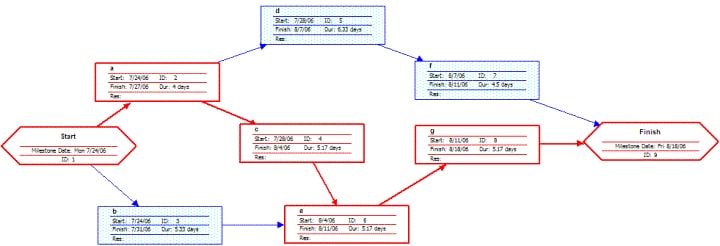Critical Path Method Project

Critical Path Method Project – Estimating Resources and Activity Schedules
The Critical Path Method is a powerful tool of project management. It is employed in the projects containing interdependent activities and used for scheduling the activities. It highlights the critical path, provides a clue to the completion date and controls the overall project expenses.
Projects of a large organization are always multidimensional and multi-tasked. They take many activities and resources to initiate, to complete on schedule and bring success for the organization. The activities are also dependent upon each other. The project planners do take into account all these things into consideration while designing the CPM chart of these projects. A chart of a multidimensional and complex project, for instance, looks like the following diagram:

The chart from a database design project here points out to the project schedule, various tasks and activities represented in square boxes, critical path outlined in red and the start date, end date of the project, the project team along with budgetary allocation to complete each task. All these form the resources of a multidimensional CPM project.
Project Resources
Resource allocation is an important factor under consideration for the project managers. They take into account the amount of resources available for the individual task first before allocating them to their team. One also needs to know a few scheduling terms such as Finish to Start (FS), Start to Start (SS), Finish to Finish (FF) and Start to Finish (SF), etc while allocating the resources to the project team. The project also demands them to specify the resources for each activity in the project before executing the plan. There are of course limitations on the availability of resources, but the experience in designing the CPM chart comes handy to overcome the problem.
Let’s see some of these resources which help the managers execute their CPM on the ground.
1. Schedule
Scheduling the project perfectly is the most important thing required by the project planners in a CPM module. The project schedule is the heart of any project. A properly designed schedule helps the managers execute the plan with the allotted resources. It also lets the managers be prepared for risks, communicate effectively with his team/s, regulate and alter the activities to start early or implement late according to the situation. In case of delay, the manager either can advance that activity or bring other activities to accelerate the lag.
2. Task/Activities
A CPM project is based on many tasks. These are the project activities that have start and finish dates. Normally a fixed duration is assigned to each activity. Project managers monitor this duration and alter the schedule if necessary. It is the responsibility of the project planners and managers to determine exact duration of the activity. The following table of activities from a database creation project may give us an idea of scheduling the tasks with proper duration:
| Task | Activity | Estimated Duration |
| 1 | Collection of Project Requirements | 1 Day |
| 2 | Database Concept and Designing Process | 3 Days |
| 3 | Database creation | 7 Days |
| 4 | Planning & creating data Views | 2 Days |
| 5 | Planning & designing data classes | 2 Days |
| 6 | Database coding | 5 Days |
| 7 | Planning and designing database GUI | 7 Days |
| 8 | Creating data entry forms | 4 Days |
| 9 | Creating report forms | 4 Days |
Experience in managing difficult project as such does help in calculating the time required to complete a task. If not, to estimate the duration managers should consult the people who perform the activities on ground. That will help them properly monitor and manage the ongoing activities of the project. It is especially true in construction and database creation projects where unforeseen circumstances sometimes disturb the duration. Hence, consulting the expert in the task gives better results.
3. Critical Path
Critical path is the most important of the CPM resources. It is the sequence of activities in a network that determines the duration of the project. Every project has a critical path. For project managers it is a technique to identify the task/s that have an impact on the end date of the project and is usually designed in the graphical form. It enables the project to complete on time by calculating and monitoring the exact duration of the tasks. Determining the activities that are time bound is therefore an utmost necessity. The activities marked in red in the above diagram for example inform the managers which activity needs to be focused or which delayed one needs accelerating. It is the critical path of the project.
Observing these rules allow the managers to design a proper project schedule to bring even the most difficult of projects to success on or before its scheduled finish date. That also gives them a much-needed career boost to face the hard challenges ahead.
